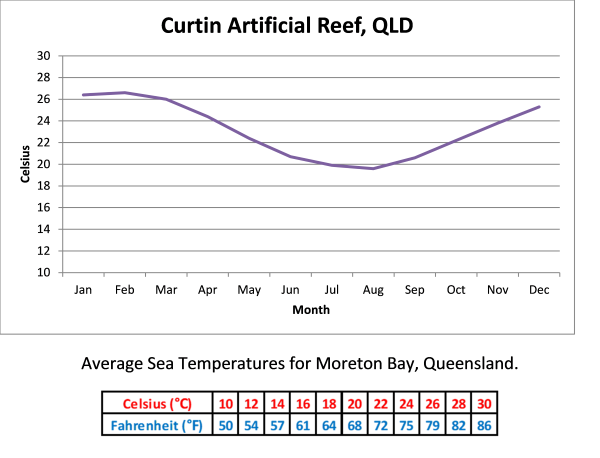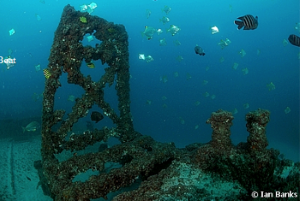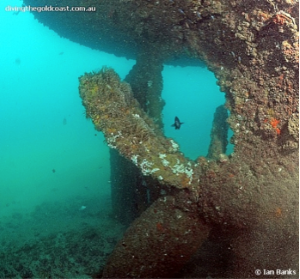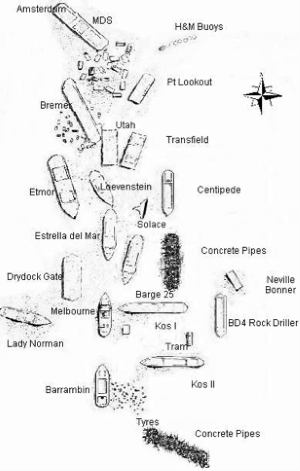CURTIN ARTIFICIAL REEF
|
| Type of dive: |
|
Scuttled wrecks |
| Snorkelling: |
|
No, too deep! |
| Scuba: |
|
Open Water (Advanced recommended) |
| Access: |
|
Boat only (60 minutes) |
| Depth: |
|
12 – 35 metres (40-115’) |
| Visibility: |
|
8 – 25 metres (25-80’) |
| Water temperature: |
|
20 – 26°C (68-79°F) |
| Seasonal: |
|
No, can visit anytime |
Brisbane divers were truly ahead of their time!
In 1968, the Underwater Research Group of Queensland embarked on a visionary project, the Curtin Artificial Reef, just off Moreton Island near Brisbane. The project was named after the late Frank Curtin, a member of the group who had the insight for what, in its day, was an extraordinary concept.
Morton Island is a short boat ride across Moreton Bay from Brisbane and is the world’s third largest sand island after K’gari (Fraser Island) to the north, and North Stradbroke Island to the south.
The only rocky outcrop on Moreton Island is Cape Moreton, the site of Queensland’s oldest lighthouse.
Over the years, the island has been the location of a sea pilot station, used as Queensland’s only whaling station responsible for the harvesting around 600 whales per season from 1952 to 1962, and limited mineral sand mining.
Moreton Island is now a resort island and Tangalooma on the western side of the island has a breakwater made up of 15 wrecks scuttled in shallow water.
Tangalooma Wrecks is a fantastic snorkelling spot!
Curtin Artificial Reef is on the western end of Moreton Island and covers an area of over 40,000 square metres (10 ac). The first vessel prepared and sunk on the sand bottom was the 18 metre (60’) barge, Amsterdam, and there are now over 30 wrecks.
The sunken potpourri includes tugs, barges, a yacht, a car ferry, over 2000 concrete pipes, over 60 car bodies, navigation buoys, a dry dock gate and an even an old Brisbane tram.
The largest vessel is the Bremer (50m/164‘), and the last vessel to be scuttled was the tug, Hustler, in 1998.
Now the artificial reef boasts an extraordinary array of marine life.
Structures have become a substrate for corals and support a host of other invertebrates including nudibranchs, sea stars and sea urchins, and a keen eye may also spot pipefish and sea horses.
The broken bottom created by the wrecks attracts huge schools of fish, including colourful tropical reef fish.
Massive Queensland groper hover around the wrecks while wobbegongs and bull rays are ever present on the sandy bottom. Massive schools of barracuda, turrum, bat fish and trevally adorn the wrecks while sharks and pelagic fish such as kingfish, mackerel and cobia are regular visitors encountered by scuba divers.
Lucky divers might even encounter a dugong on the boat trip out!
Copyright © 2024 Steve Sinclair
Other great dive sites to visit while you are there:
Flinders Reef, Tangalooma Wrecks, Lighthouse Bommie, Three Pyramids and Encounters.
Local dive services:
|
|
BRISBANE SCUBA |
 |
BLAST EXPERIENCES |







OTHER INFORMATION
LOCATION
State or Territory:
Queensland
Nearest City:
Brisbane
Nearest Regional City:
Not applicable
Nearest Town:
Not applicable
HOW TO GET THERE
Air:
Nearest International Airport:
Brisbane
Nearest Domestic/Regional Airport:
Brisbane
Road:
Just over 3 hours via car ferry
Bus:
Not relevant
Train:
Not relevant
Ferry:
From Whyte Island Brisbane
THINGS TO DO
Snorkel the Tangalooma Wrecks
Cape Moreton Lighthouse
Quad Bike Tours
Dolphin Feeding
Whale Watching



















